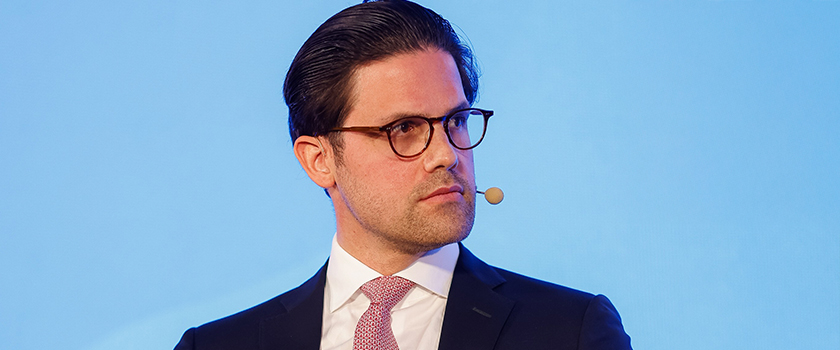Secular trends encompass thematic opportunities with the potential to have a material effect on the world and financial landscapes with long-term and lasting consequences. At UBP, we have identified four major underlying themes associated with the consumption patterns trend: digital consumerism; generational consumerism; global consumerism; conscious consumerism. We believe that investing in the underlying themes with highly skilled, active managers is the best way to gain exposure to this trend and capture growth opportunities.
Why thematic investing?
Traditional approaches to investing are constantly challenged by leading companies which, by nature, are innovative and, for most of them, multisectoral. Disruptors can be found in any sector or industry, making the traditional industry classification framework increasingly less relevant. Disruption is blurring the lines between countries, sectors, and industries. Therefore, looking at the world through a thematic lens allows investment professionals to access the whole spectrum of opportunities.
Along with climate change, demographics and disruptive innovation, the evolution of consumer spending patterns is one of four trends impacting the global economy and transforming old habits. At UBP, we believe these trends will capture the key shifts affecting global businesses and society over the coming decades, and therefore offer an exciting starting point to identify long-term investment opportunities. However, these four long-term trends are affecting not just the planet, but also the financial markets and those who participate in them; that said, they are often too large and move too quickly for investors to grasp. As traditional classifications become obsolete, many portfolio managers are throwing off the shackles of conventional, sector-driven and passive investments, and are instead adopting theme-based solutions. But how can a themed approach deliver superior investment returns by viewing the future in the light of the erratic consumption patterns trend?
Changing patterns: survival of the fittest
Demographic and technological developments have precipitated the evolution of the traditional consumer model and reshaped consumption patterns. By consumption we are not just talking about purchasing products but also the consumption of, for example, technologies, services and experiences. In order to grasp how consumption patterns are evolving, it is crucial to understand what is driving the shifts in these patterns, both today and in the future. In some instances, the drivers of change are structural and in others more cyclical; some have been evolving for decades and others are relatively nascent.
Thanks again in part to technological developments, change such as this happens faster today than ever before, making it crucial for all those reliant on the consumer to stay relevant. This also presents numerous opportunities for forward thinking and for nimble market participants to exploit.
Digital consumerism
Technology – and the digitalisation of virtually everything – has had a substantial impact on how consumer patterns have evolved. These developments have enabled the consumer to be more demanding and more discerning in what they consume, but crucially how they do so; there is now more choice for consumers than ever before as entry to the market is facilitated by the internet and social media as a means of direct, cost-effective advertising. These new distribution channels are making it much easier for smaller businesses to distribute their products, and owning the distribution channels is no longer a big advantage. As a result, the economic moat that consumer companies have been building over decades is drying up. In this way, the consumer has taken much of the power away from the producer/retailer; brand power and prestige are no longer enough.
Today, we have same-day delivery options, price comparison and review forums, which mean that if you are not producing the best value, in the most time-efficient manner and to the customer’s complete satisfaction, then you risk falling behind.
Experience is everything. An omnichannel shopping experience is now becoming the norm, and fast becoming the basic expectation, especially for the digital natives of the younger generations; this means offering the best online and in-person shopping experience. An overarching aspect of the consumer evolution is the decline of the middleman and the move towards direct transactions. This ongoing evolution of how we shop is crucial to the consumption story, as not understanding or not adapting to this consumer expectation could be detrimental to any brand.
Generational consumerism
Developments in the world’s demographic make-up have been pivotal in driving today’s global demand and consumption, and should continue to be so in the future. The ageing population is an international phenomenon that will see the number of people over the age of sixty double by 2050, thereby making up more than 20% of the global population. In thinking about consumption, it is therefore key to understand how this growing demographic “consumes”, not least because this segment of the population also holds a large share of the total wealth.
Although ageing populations represent a key shift in consumers, they are not the only demographic contributing to the evolution of consumption patterns. Taking Millennials (or Generation Y, i.e. those born between 1981 and 1996) and Generation Z (born between 1997 and 2012) as an example: they display strong consumer patterns and preferences. It is important to highlight a key difference between developed and emerging markets: while Millennials born in developed countries are likely to be affected by high housing costs, student debt, job instability and tend to be poorer than their parents who have benefited from years of economic boom, their emerging market peers tend to have greater opportunities, be more internationally oriented and probably wealthier than their parents. As a result, the former group tend to be, on average, price conscious and focused on utility, while the latter group tend to give more importance to aspirational consumption, such as luxury products and experiences. Globally, Generation Z is strongly focussed on accessing services rather than owning products – more so than any generation before; examples of this include ride-sharing and subscription-service streaming. Also, being far more technologically minded, their shopping and online experiences are vital to them.
Global consumerism
We need only look back just ten years to see a very different consumption landscape in order to realise how quickly and how dramatically things have changed. Take international calling and texting apps, ride-sharing apps and 4G; all were almost non-existent a decade ago, and before we had them, did we even know we needed them?
Understanding the consumer is key to this. Of course, the consumer is heterogeneous and has different wants depending on age, income bracket, geography and specific preferences. That said, we can generalise to a certain extent. Over the next ten years, the average global consumer will be slightly older, should be more urban, slightly wealthier but time poorer.
Conscious consumerism
While discerning in their tastes and commerce experiences, today’s consumers are becoming increasingly conscious of the societal and environmental impact of what they do and what they buy.
Rising awareness of climate change, sustainability and ecology from a consumption angle has necessitated a shift for suppliers, retailers and the like to offer these options to their customers or risk losing them entirely. This is especially pertinent, as research has shown that consumers are now willing to pay more for products and services considered to be “better” in terms of their environmental and ecological footprints.
There are thousands of examples of sub-trends that result from this increasing consumer shift, with ramifications across all industries, from what we wear (textiles/labour/non-animal derived), what we eat (veganism/less CO2/suitably sourced/animal welfare), to what we buy (sustainable choices/recyclable/packing).
A good example of where this can be seen is in the fashion and cosmetics industries, where the provenance of raw materials has become very important to would-be shoppers, and companies are increasingly being forced to display the origins of their goods; fashion brands are launching sustainable lines. In response to customer pressure, a number of brands now include all the information on material sourcing.
This so-called “conscious consumerism” extends to make-up and cosmetic brands, which are also quickly evolving to meet the demand for more animal-friendly, plant-based products. Again, the companies that have managed to adapt to these changing consumption preferences tend to do well and those who have not tend to struggle.
This growing awareness among consumers extends to their own health and well-being. There is an obvious, fast-growing interest in healthy eating across age brackets, as evidenced by the consumption of nutritional supplements, fitness trackers and “athleisure” wear. Many companies have had huge success in recent years playing on the rise of the healthy consumer.
Millennials and Generation Z are especially sensitive to the sustainability of what they buy, do and consume. Since Generation Z is predicted to make up around 40% of global consumers in 2020, this is not an insignificant aspect. This also goes back to the earlier point that today the consumer is increasingly demanding; more and more consumers, especially in this demographic, are saying they will substitute a traditional brand for a more environmentally friendly version, if one is available. The ability to make this choice is, of course, further facilitated by technology.
Evolutionary consumerism
The result of this ongoing evolution in consumer behaviour and consumption patterns is a complex mix of many aspects, including products, preferences, and provenance, and producers and retailers need to respond to this to stay competitive. Consumers have become experts in all fields, thanks again to the internet, but while technology has afforded greater and more direct access to the consumer, it has also increased competition.
And so we see that the new wave of consumption is driven by many facets and preferences: the global consumer, the Millennial consumer, the more eco-conscious consumer and the digital consumer. With such a broad scope and an everchanging landscape, the best way to capitalise on this trend is via a broad and diversified approach to investing in actively managed funds that play to each of these themes. As the pace at which tastes can change and new entrants can disrupt, diversification can offer the most sensible and varied access to this multi-faceted trend.








